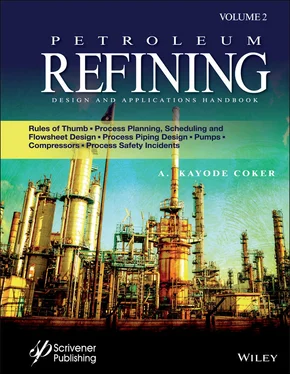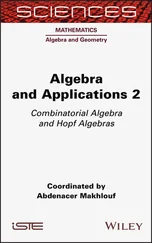A. Kayode Coker - Petroleum Refining Design and Applications Handbook
Здесь есть возможность читать онлайн «A. Kayode Coker - Petroleum Refining Design and Applications Handbook» — ознакомительный отрывок электронной книги совершенно бесплатно, а после прочтения отрывка купить полную версию. В некоторых случаях можно слушать аудио, скачать через торрент в формате fb2 и присутствует краткое содержание. Жанр: unrecognised, на английском языке. Описание произведения, (предисловие) а так же отзывы посетителей доступны на портале библиотеки ЛибКат.
- Название:Petroleum Refining Design and Applications Handbook
- Автор:
- Жанр:
- Год:неизвестен
- ISBN:нет данных
- Рейтинг книги:3 / 5. Голосов: 1
-
Избранное:Добавить в избранное
- Отзывы:
-
Ваша оценка:
- 60
- 1
- 2
- 3
- 4
- 5
Petroleum Refining Design and Applications Handbook: краткое содержание, описание и аннотация
Предлагаем к чтению аннотацию, описание, краткое содержание или предисловие (зависит от того, что написал сам автор книги «Petroleum Refining Design and Applications Handbook»). Если вы не нашли необходимую информацию о книге — напишите в комментариях, мы постараемся отыскать её.
Petroleum Refining Design and Applications Handbook — читать онлайн ознакомительный отрывок
Ниже представлен текст книги, разбитый по страницам. Система сохранения места последней прочитанной страницы, позволяет с удобством читать онлайн бесплатно книгу «Petroleum Refining Design and Applications Handbook», без необходимости каждый раз заново искать на чём Вы остановились. Поставьте закладку, и сможете в любой момент перейти на страницу, на которой закончили чтение.
Интервал:
Закладка:
4 Chapter 17Figure 17.1A General areas of compressing equipment application (source: De Jard...Figure 17.1B Approximate ranges of application for usual process reciprocating c...Figure 17.1C Typical application ranges for turbocompressor capabilities extend ...Figure 17.1D Basic compressor types (used by permission: Coker, A. K. Hydrocarbo...Figure 17.1E Types of compressors.Figure 17.2A Sectional assembly. Worthington single stage, belt-driven air compr...Figure 17.2B Cutaway view of typical high pressure gas cylinder showing double-d...Figure 17.2C Dry vacuum pump cylinder for very low absolute suction pressures. V...Figure 17.2D Standard air compressor cylinder for 125 psig discharge pressure. S...Figure 17.2E A 250 psig working pressure cylinder used in refrigeration service....Figure 17.2F Typical linear-type cast iron cylinder.Figure 17.2G Typical non-lubricated recycle cylinder.Figure 17.2H Double-acting cast steel cylinder to 3500 psi pressure (used by per...Figure 17.2I Double-acting cast Meehanite or ductile iron cylinder to 1250 psi p...Figure 17.2J Double-acting Meehanite metal or ductile iron cylinder to 1000 psi ...Figure 17.2K Forged steel single-acting for 6000 psi pressure (used by permissio...Figure 17.2L Typical forged steel cylinder with tail-rod.Figure 17.2M For low compression ratios, designed for 1000 psi discharge pressur...Figure 17.2N Designed for working pressure up to 6500 psi. A similar design cyli...Figure 17.2O Fourth and fifth-stage cylinder assembly of 3500 psi pressure hydro...Figure 17.2P Fifth and sixth-stage cylinder assembly of 15,000 psi gas compresso...Figure 17.2Q Cast or nodular iron cylinders for pressures to 1500 psi. Note doub...Figure 17.2Q (a) Long, single compartment distance piece (sufficient length for ...Figure 17.2R Fabricated carbon or stainless-steel cylinders for special applicat...Figure 17.2S Forged steel cylinder with tail-rod design (right) for pressure to ...Figure 17.2T Medium or high pressure, double-acting cylinder with flanged liner....Figure 17.2U High pressure, circulator-type cylinder, double-acting. The steel c...Figure 17.3A Typical cross-section of motor-driven, single-stage compressor.Figure 17.3B Partial cross-section of balanced opposed compression cylinders.Figure 17.4 Cylinder action.Figure 17.5A–D Cylinder arrangement.Figure 17.5E Balanced arrangement for Dresser-Rand shaft system, 1–10 crank thro...Figure 17.5F Lubricated and non-lubricated balanced opposed process reciprocatin...Figure 17.6A Double-deck feather valve (used by permission: Dresser-Rand Company...Figure 17.6B Double-deck valve with valve cap unloader (used by permission: Coop...Figure 17.6C Action of gas flow through strip-type feather valve (used by permis...Figure 17.6D Plate-type valves (used by permission: Dresser-Rand Company).Figure 17.6E Channel-type valves (used by permission: Ingersoll-Rand Company).Figure 17.6F Ring channel valves (used by permission: Cooper-Cameron Corporation...Figure 17.6G AJAX® APV-100, high-efficiency compressor valve. Suction and discha...Figure 17.6H Dresser-Rand specialized valve (used by permission: Bul. 3640. Dres...Figure 17.6I Dresser-Rand HPS proprietary valve design, using proprietary blend ...Figure 17.6J Variety of standard and special valves designed and fabricated by t...Figure 17.7 Piston rods. Precision-manufactured rolled threads and induction har...Figure 17.7A Stuffing box with rod packing direct and indirect cooling (used by ...Figure 17.8 Piston and rings. Lubricated and non-lubricated pistons with PTFE or...Figure 17.8A Piston rings. The piston rod is manufactured from heat treated stai...Figure 17.9 Piston rod packing. To meet the latest environmental requirements fo...Figure 17.10 Reciprocating compressor specifications.Figure 17.11 Ideal pressure–volume cylinder action for single acting compressor ...Figure 17.12 Reciprocating compressor compression diagrams. Actual losses and ef...Figure 17.12A Illustration of isentropic path on log pressure-enthalpy diagram, ...Figure 17.12B Section of ethane pressure-enthalpy diagram illustrating five comp...Figure 17.13A Enthalpy-entropy chart for natural gas, Sp.Gr. = 0.6 (used by perm...Figure l7.13B Enthalpy-entropy chart for natural gas, Sp.Gr. = 0.7 (used by perm...Figure l7.13C Enthalpy-entropy chart for natural gas, Sp.Gr. = 0.8 (used by perm...Figure l7.13D Enthalpy-entropy chart for natural gas, Sp.Gr. = 0.8 (used by perm...Figure 17.14A Compressibility factor for gases, Part 1 of 5 (used by permission:...Figure 17.14B Compressibility factor for gases, Part 2 of 5 (used by permission:...Figure 17.14C Compressibility factor for gases, Part 3 of 5 (used by permission:...Figure 17.14D Compressibility factor for gases, Part 4 of 5 (used by permission:...Figure 17.14E Compressibility factor for gases, Part 5 of 5 (used by permission:...Figure 17.14F Compressibility factor for air (used by permission: From 3519 D (1...Figure 17.14G Compressibility chart for ammonia (used by permission: From 3519 D...Figure 17.14H Compressibility chart for chlorine (used by permission: From 3519 ...Figure 17.14I Compressibility chart for nitrogen (used by permission: From 3519 ...Figure 17.14J Compressibility chart for low pressure carbon dioxide (used by per...Figure 17.14K Compressibility chart for high pressure carbon dioxide (used by pe...Figure 17.14L Compressibility chart for methane (used by permission: From 3519 D...Figure 17.14M Compressibility chart for low pressure ethylene (used by permissio...Figure 17.14N Compressibility chart for high pressure ethylene. Note: special ch...Figure 17.14O Compressibility chart for low pressure ethane (used by permission ...Figure 17.14P Compressibility chart for high pressure ethane (used by permission...Figure 17.14Q Compressibility chart for propylene (used by permission from 3519D...Figure 17.14R Compressibility chart for low pressure propane (used by permission...Figure 17.14S Compressibility chart for high pressure propane (used by permissio...Figure 17.14T Compressibility chart for low pressure N-butane (used by permissio...Figure 17.14U Compressibility chart for high pressure N-butane (used by permissi...Figure 17.14V Compressibility chart for low pressure iso-butane (used by permiss...Figure 17.14W Compressibility chart for high pressure iso-butane (used by permis...Figure 17.15 Compressibility factor for natural gas (used by permission: G.G. Ob...Figure 17.16A–C Deviations from the ideal gas law.Figure 17.16D Typical compressor aliments and how they look on P-T diagrams (use...Figure 17.17A Combined indicator cards from a two-stage compressor showing how c...Figure 17.17B Effects of clearance volume on performance efficiency of reciproca...Figure 17.18A Compressor volumetric efficiency curve for gas with k or n of 1.15...Figure 17.18B Compressor volumetric efficiency curve for gas with k or n of 1.20...Figure 17.18C Compressor volumetric efficiency curve for gas with k or n of 1.25...Figure 17.18D Compressor volumetric efficiency curve for gas with k or n of 1.30...Figure 17.18E Compressor volumetric efficiency curve for gas with k or n of 1.35...Figure 17.18F Compressor volumetric efficiency curve for gas with k or n of 1.40...Figure 17.19 Loss factor curve (used by permission: Cooper-Cameron Corporation).Figure 17.20 Chart for solving theoretical work of compression or expansion (use...Figure 17.21A Brake horsepower required to deliver 1 million ft 3of gas per day,...Figure 17.21B Brake horsepower required to deliver 1 million ft 3of gas per day,...Figure 17.21C Brake horsepower required to deliver 1 million ft3 of gas per day,...Figure 17.22 Compression temperature rise (used by permission: Rice, W. T., Chem...Figure 17.23 Barometric and atmospheric pressure at altitudes.Figure 17.24 Conventional Trickle Bed Process Flow Diagram.Figure 17.25 Iso Therming process flow diagram.Figure 17.26 Horizontal configuration of recycle pump [170].Figure 17.27 Liquid flow path in IsoTherming ® Recycle pump [170].Figure 17.28 Photograph: Top view of IsoTherming ® Recycle pump [170].Figure 17.29 A photograph of IsoTherming recycle pump [170].Figure 17.30 Feed sulfur content data during commercial operation of the IsoTher...Figure 17.31 Chemical hydrogen consumption data during commercial operation of t...Figure 17.32 IsoTherming® 3-D layout plot [170].Figure 17.33 A photograph of IsoTherming® hydroprocessing unit [170].Figure 17.34A UniSim Design Desktop (source: UniSim Design® R460.1. Honeywell® a...Figure 17.34B (source: UniSim Design® R460.1. Honeywell® and UniSim® are registe...Figure 17.34C (source: UniSim Design® R460.1. Honeywell® and UniSim® are registe...Figure 17.34D (source: UniSim Design® R460.1. Honeywell® and UniSim® are registe...Figure 17.34E (source: UniSim Design® R460.1. Honeywell® and UniSim® are registe...Figure 17.34F (source: UniSim Design® R460.1. Honeywell® and UniSim® are registe...Figure 17.34G (source: UniSim Design® R460.1. Honeywell® and UniSim® are registe...Figure 17.34H (source: UniSim Design® R460.1. Honeywell® and UniSim® are registe...Figure 17.34I (source: UniSim Design® R460.1. Honeywell® and UniSim® are registe...Figure 17.34J (source: UniSim Design® R460.1. Honeywell® and UniSim® are registe...Figure 17.34K (source: UniSim Design® R460.1. Honeywell® and UniSim® are registe...Figure 17.34L (source: UniSim Design® R460.1. Honeywell® and UniSim® are registe...Figure 17.34M (source: UniSim Design® R460.1. Honeywell® and UniSim® are registe...Figure 17.34N (source: UniSim Design® R460.1. Honeywell® and UniSim® are registe...Figure 17.34O (source: UniSim Design® R460.1. Honeywell® and UniSim® are registe...Figure 17.34P (source: UniSim Design® R460.1. Honeywell® and UniSim® are registe...Figure 17.34Q (source: UniSim Design® R460.1. Honeywell® and UniSim® are registe...Figure 17.34R (source: UniSim Design® R460.1. Honeywell® and UniSim® are registe...Figure 17.34S (source: UniSim Design® R460.1. Honeywell® and UniSim® are registe...Figure 17.34T (source: UniSim Design® R460.1. Honeywell® and UniSim® are registe...Figure 17.34U (source: UniSim Design® R460.1. Honeywell® and UniSim® are registe...Figure 17.34V (source: UniSim Design® R460.1. Honeywell® and UniSim® are registe...Figure 17.34W (source: UniSim Design® R460.1. Honeywell® and UniSim® are registe...Figure 17.34X (source: UniSim Design® R460.1. Honeywell® and UniSim® are registe...Figure 17.34Y (source: UniSim Design® R460.1. Honeywell® and UniSim® are registe...Figure 17.34Z (source: UniSim Design® R460.1. Honeywell® and UniSim® are registe...Figure 17.34Z1 (source: UniSim Design® R460.1. Honeywell® and UniSim® are regist...Figure 17.34Z2 (source: UniSim Design® R460.1. Honeywell® and UniSim® are regist...Figure 17.35A Mollier chart for properties of ammonia (used by permission: Dept....Figure 17.35B Mollier diagram of the properties of ammonia. Note the different c...Figure 17.35C Mollier diagram of the properties of methane (used by permission. ...Figure 17.35D Mollier diagram of the properties of ethane (used by permission. E...Figure 17.35E Mollier diagram of the properties of ethylene. Note: ethylene char...Figure 17.35F Mollier diagram of the properties of propylene (used by permission...Figure 17.35G Mollier diagram of the properties of propane (used by permission. ...Figure 17.35H Mollier diagram of the properties of iso-butane (used by permissio...Figure 17.36 Combined compression and mechanical efficiency of reciprocating com...Figure 17.37 Horsepower characteristic curves for constant discharge pressure, k...Figure 17.38 Horsepower characteristic curves for constant suction pressure, k =...Figure 17.39 Automatic cylinder unloading (used by permission: Worthington Bul. ...Figure 17.40A Five-step clearance pocket control for compressor unloading (used ...Figure 17.40B Five-step control for compressor unloading (used by permission: Wo...Figure 17.41A Fixed volume clearance pockets (used by permission: Worthington Bu...Figure 17.41B Variable volume clearance pockets (used by permission: Worthington...Figure 17.42A Pneumatically operated clearance bottle (used by permission: Bul. ...Figure 17.43 Compressor cylinder performance curve for unloading conditions.Figure 17.44A Single-stage horizontal compressor (used by permission: Dresser-Ra...Figure 17.44B Two-stage angle-type vertical compressor (used by permission: Dres...Figure 17.44C Two-stage horizontal duplex compressor (used by permission: Dresse...Figure 17.45 Typical air compressor performance, single and two-stage (adapted a...Figure 17.46 Air properties compression chart (used by permission: Rice, W. T., ...Figure 17.47 Benefits of interstage cooling for air compression system (used by ...Figure 17.48 Work associated with three types of air compression (used by permis...Figure 17.49 Moisture as precipitated by aftercoolers (used by permission: Bul. ...Figure 17.50A Internal construction features of multistage centrifugal compresso...Figure 17.50B Construction features of multistage centrifugal compressor (used b...Figure 17.50C Single-stage gas compressor with integrally geared drive shaft (us...Figure 17.50D Oil-free air compressor with two impellers, Elliot Company. “Plant...Figure 17.51A Centrifugal compressor case types. These usually apply to multista...Figure 17.51B Flow path arrangements: Compound flow (used by permission: Bul. 42...Figure 17.51C Flow path arrangements: Sidestream flow (used by permission: Bul. ...Figure 17.51D Flow path arrangements: Back-to-Back flow (used by permission: Bul...Figure 17.51E Barrel type compressor section, horizontal mounting (used by permi...Figure 17.52 Single impeller centrifugal blower (used by permission: Elliot® Com...Figure 17.53 Results of internal chlorine gas fire and extensive corrosion in ce...Figure 17.54A Multistage centrifugal compressor uncooled diaphragms for horizont...Figure 17.54B Diaphragms (used by permission: Bul. PROM 526/15/95, © S.pA. Nuovo...Figure 17.55A Water-cooled diaphragm (used by permission: Dresser-Rand Company).Figure 17.55B Single stage centrifugal compressor with variable inlet vanes, dia...Figure 17.56 Labyrinth seals (used by permission: Dresser-Rand Company).Figure 17.57A Impeller with milled vanes on solid disc forging (used by permissi...Figure 17.57B A special design riveted wheel, used only on small wheels where we...Figure 17.57C Cutaway of riveted wheel. Blades are riveted to hub disc, and the ...Figure 17.57D Part 1. View toward inlet of 4½ in. diameter brazed aluminum impel...Figure 17.57D Part 2. Close-up welding of section of welded impeller (used by pe...Figure 17.57E Radial impeller for single stage compressor (used by permission: A...Figure 17.57F Open radial blade impeller, Type “R” (used by permission: Bul. “Ce...Figure 17.57G Open impeller with backward-leaning blades, Type “SR” (used by per...Figure 17.57H Advanced datum impeller design reduces operating stresses and impr...Figure 17.57I Part 1. Impeller geometry versus flow y, dimensionless to define t...Figure 17.57I Part 2. The graph shows the influence of the flow coefficient, Φ o...Figure 17.57 Part 3. Stage performance of a compressor is usually represented in...Figure 17.58 Gas flow through inlet guide vanes; power wheel shows a head of fir...Figure 17.59A Inlet prerotation vanes (used by permission: York International).Figure 17.59B Single stage blower with automatically controlled inlet vanes (use...Figure 17.60A Kingsbury-type thrust bearing (used by permission: Elliot® Company...Figure 17.60B Kingsbury-type thrust bearing for centrifugal compressor (used by ...Figure 17.61A Centrifugal compressor auxiliaries–forced feed lubrication system ...Figure 17.61B A forced feed lube system ensures that journal and thrust bearings...Figure 17.61C The seal of oil system filtered oil to the liquid film rings or to...Figure 17.61D A photograph of a turbine for the crude distillation unit.Figure 17.62A Multistage centrifugal compressor shaft seal arrangements (used by...Figure 17.62B Shaft seal options (used by permission: Bul. 2781005301, © 1988. A...Figure 17.63 (A) Straight-pass labyrinth seal; (B) staggered labyrinth seal; (C)...Figure 17.64 Packing box arrangement.Figure 17.65 Mechanical wet contact type seal (used by permission: Elliot® Compa...Figure 17.66 Liquid film seal (used by permission: Elliot® Company).Figure 17.67 Estimates of process gas seal leakage using nitrogen as sealing gas...Figure 17.68 Centrifugal compressor specifications.Figure 17.69 Generalized centrifugal compressor pressure–capacity chart for vert...Figure 17.70 Performance ranges for special high-speed/high pressure, single-sta...Figure 17.71 Compressor in a centrifugal machine.Figure 17.72 Manufacturer’s typical centrifugal compressor characteristic curve.Figure 17.72A Typical performance map of centrifugal compressor (used by permiss...Figure 17.72B Performance examination of one set of centrifugal compressor condi...Figure 17.72C Performance examination of a second set of centrifugal compressor ...Figure 17.72D Centrifugal compressor surge control schematic diagram shows instr...Figure 17.72E Control system monitors discharge pressure and flow to prevent sur...Figure 17.73 Representative centrifugal compressor performance with inlet guide ...Figure 17.74 Ratio of specific heats (n − 1)/n (used by permission: Dresser-Rand...Figure 17.75 Specific volume chart (used by permission: © Elliot Co.).Figure 17.76 Relationship between adiabatic and polytropic efficiencies (used by...Figure 17.76A Polytropic to adiabatic efficiency conversion (used by permission:...Figure 17.77 Comparative efficiencies of a 1550 bhp centrifugal compressor based...Figure 17.78 Approximate head selection (used by permission: Elliot® Co.).Figure 17.79 Brake horsepower per million ft 3per day for compressors as a funct...Figure 17.80 Correction factor for compressor bhp/million ft 3per day at 14.7 ps...Figure 17.81 Entropy–temperature diagrams help to solve compression work problem...Figure 17.81A Basic concepts for solutions using the Mollier diagram of a specif...Figure 17.81B Typical mechanical losses for seals on shafts of centrifugal compr...Figure 17.82 Polytropic compressor discharge temperature (used by permission: El...Figure 17.83 Sonic velocity of common gases (used by permission: Koenig, C. F.II...Figure 17.84 Centrifugal compressor size versus capacity (used by permission: Dr...Figure 17.85 Compression ratio versus number of impellers; uncooled compression ...Figure 17.86 Peripheral velocity or impeller tip speed versus head per impeller ...Figure 17.87 Uncooled compressor relationship between adiabatic efficiency and p...Figure 17.88 Reciprocating compressor efficiencies.Figure 17.89 The Simulation Basis Manager window of UniSim Design R451 (courtesy...Figure 17.90 Component List View Component List-1 of UniSim Design R451 (courtes...Figure 17.91 Fluid Package of UniSim Design R451 (courtesy, Honeywell Process So...Figure 17.92 Composition tab of Worksheet window of UniSim Design R451 (courtesy...Figure 17.93 Connection tab of Compressor of UniSim Design R451 (courtesy, Honey...Figure 17.94 Parameter tab of Design of Compressor of UniSim Design R451 (courte...Figure 17.95 Conditions page of Worksheet tab of Design of Compressor of UniSim ...Figure 17.96 Worksheet tab of UniSim Design R451 (courtesy, Honeywell Process So...Figure 17.97 PFD of UniSim Design R451 (Honeywell® and UniSim® are registered tr...Figure 17.98 Schematic flow diagram of a two-phase compression process.Figure 17.99 Worksheet window of the adiabatic flash vessel showing fraction of ...Figure 17.100 Worksheet window of the pump P.101 showing pump power of 7274 kJ/h...Figure 17.101 Worksheet window of the compressor C1 showing compressor power of ...Figure 17.102 Worksheet window of the Cooler E-1 showing the duty of 3.079 × 10 5...Figure 17.103 Process flow diagram of the two-phase compression simulation (cour...Figure 17.104 Stream information in the compressor connection of the Design page...Figure 17.105 Specifying compressor adiabatic efficiency in the connection of th...Figure 17.106 Calculated results in the Worksheet page of the simulated compress...Figure 17.107 Process flow diagram of Example 17.14 (courtesy, Honeywell Process...Figure 17.108 Process flow diagram of the two-stage compression of natural gas.Figure 17.109 Screen shot of the Connection Tab of Recycle RCY-1 (courtesy, Hone...Figure 17.110 Screen shot of the Parameters Tab in the Connection page (courtesy...Figure 17.111 Screen shot of The Numerical Page containing the numerical options...Figure 17.112 Screen shot of the Monitor page (courtesy, Honeywell Process Solut...Figure 17.113 Process flow diagram of the two-stage compression of natural gas (...Figure 17.114 Compressor performance curve, head reduction (source: Scott Golden...Figure 17.115 Compressor and connected system.Figure 17.116 Suction pressure vs. wet gas production (source: Scott Golden, et ...Figure 17.117 Suction temperature vs. wet gas production (source: Scott Golden, ...Figure 17.118 Basic horsepower for a machine with intake of 14.5 psia, with “k” ...Figure 17.119 “k” value correction factor (used by permission: Cole, S. L., Oil ...Figure 17.120 Basic head for machine with “k” value for air (1.396), molecular w...Figure 17.121 Temperature rise multiplier (used by permission: Cole, S. L., Oil ...Figure 17.122 Compressor speed in rpm (used by permission: Cole, S. L., Oil and ...Figure 17.123 Effect of changing inlet conditions on performance curves. Fixed o...Figure 17.124 Relative effects of inlet temperature change on head and horsepowe...Figure 17.125 Relative effects of inlet gas specific gravity change on head and ...Figure 17.126 Effect of gas system flow resistance on comparative performance in...Figure 17.127 System operation of variable speed centrifugal compressor.Figure 17.128 Typical effects of capacity control on horsepower for centrifugal ...Figure 17.129 Changing characteristics with variable speed.Figure 17.130 Simplified multilevel refrigeration process; an example of three d...Figure 17.131 Effects of 2% and 5% “Head Rise To Surge” (HRTS) (used by permissi...Figure 17.132 Effects on inlet pressure for HRTS variations (constant speed driv...Figure 17.133 Comparison of the energy potential of turboexpanders versus thrott...Figure 17.134 Section of ethane, pressure-enthalpy diagram illustrating five exp...Figure 17.135 Typical geared-turbine-driven axial flow compressor unit (used by ...Figure 17.136 Cross section of typical nine-stage axial flow compressor (used by...Figure 17.137 Axial compressor Type AV 100-16, during erection. Note stationary ...Figure 17.138 Stator blade control mechanism on four-stage axial compressor (use...Figure 17.139 Axial rotor assembly (used by permission: A. C. Compressor Corpora...Figure 17.140 Performance of axial compressor at various speeds (used by permiss...Figure 17.141 Stable volume range extended by stator blade control (used by perm...Figure 17.142 Pressure – capacity characteristic compression of an axial compres...Figure 17.143 General axial flow compressor performance for typical 100 psia air...Figure 17.144 Speed comparison between axial and centrifugal compressor (used by...Figure 17.145A Functional operational schematic of Nash liquid ring compressor (...Figure 17.145B A partly disassembled Nash liquid ring compressor view shows the ...Figure 17.145C In a compound pump, the gas is compressed in two stages. First, t...Figure 17.146 Liquid ring compressor as gas compressor (used by permission: Nash...Figure 17.147 Automatic operating of primer by pressure control (used by permiss...Figure 17.148 Lobe-type blower construction (used by permission: Sutorbilt Corp....Figure 17.149 Operating principle for two-lobe blowers (used by permission: Bul....Figure 17.149A Roots Whispair ® Blower principle (used by permission: Bul. B-05 ...Figure 17.150 Typical performance curve for lobe-type blower (used by permission...Figure 17.151 Typical performance curve for variable-speed operation for lobe-ty...Figure 17.152A A typical cross-section showing the spiral screw rotors, lubricat...Figure 17.152B Type H Axi ® Helical Rotor positive displacement compressor. Appl...Figure 17.152C Exploded view of a screw compressor (used by permission: Price, B...Figure 17.152D Rotor set for oil-free rotary screw compressor (used by permissio...Figure 17.152E Type L Axi ® Helical rotor assembly and rotation details (used by...Figure 17.153 Typical constant-speed performance of spiral screw rotor compresso...Figure 17.154 Performance characteristics for a typical single-stage rotary heli...Figure 17.155 Typical test results of a medium-capacity spiral lobe compressor v...Figure 17.156 Cross-section of sliding-vane rotary compressor (used by permissio...Figure 17.157 Coupling drive end of Ro-Flo Sliding Vane compressor showing vanes...Figure 17.157A Performance curves for rotary-vane compressor (used by permission...Figure 17.158A Screw compressor in Howden process gas package (used by permissio...Figure 17.158B Rotary twin screw compressor (used by permission: Howden).Figure 17.158C Screw compressor (used by permission: Howden).Figure 17.158D Single screw rotor forces (source: Mark McCormick).Figure 17.158E Single screw compressor (source: Mark McCormick).Figure 17.159A General cutaway of integrally geared compressor (source: Wehrman,...Figure 17.159B General cutaway of integrally geared compressor (source: Wehrman,...Figure 17.159C Oxygen compressor, integrally geared design (source: Wehrman, Jos...Figure 17.159D Steam turbine driven integrally geared compressor with gearbox (s...Figure 17.159E Integrally geared compressor with pinion drive direct from steam ...Figure 17.160 Diaphragm gas compressor. Gas remains oil-free capable of handling...Figure 17.161 Motion of the displacing element causes the diaphragm to move into...Figure 17.162 Evolution of impeller performance (source: Renard, D.).Figure 17.163A Refrigeration compressor with multiple side streams (source: Rena...Figure 17.163B Typical compressor component upgrades.Figure 17.163C Typical steam turbine component upgrades (source: Renard, D.).Figure 17.164A Reciprocating compressor with ruptured water jacket (source: Roy ...Figure 17.164B Close-up of ruptured water jacket on compressor (source: Roy Sand...Figure 17.165 Compressor suction line arrangement [112].Figure 17.166 Correct suction volume bottle arrangement of a compressor [112].Figure 17.167 Existing suction piping of the compressor [112].
Читать дальшеИнтервал:
Закладка:
Похожие книги на «Petroleum Refining Design and Applications Handbook»
Представляем Вашему вниманию похожие книги на «Petroleum Refining Design and Applications Handbook» списком для выбора. Мы отобрали схожую по названию и смыслу литературу в надежде предоставить читателям больше вариантов отыскать новые, интересные, ещё непрочитанные произведения.
Обсуждение, отзывы о книге «Petroleum Refining Design and Applications Handbook» и просто собственные мнения читателей. Оставьте ваши комментарии, напишите, что Вы думаете о произведении, его смысле или главных героях. Укажите что конкретно понравилось, а что нет, и почему Вы так считаете.












